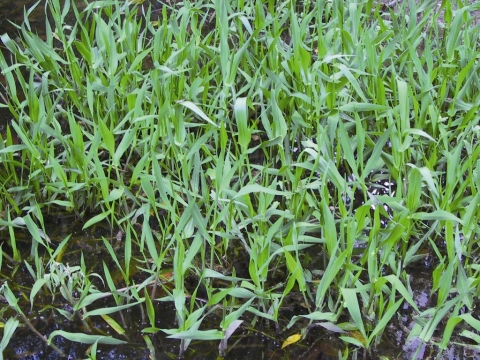Hymenachne amplexicaulis
(Rudge) Nees
Poaceae
Agrostis monostachya Poir.
Hymenachne acutigluma (Steud.) Gilliland
Hymenachne calamitosa J.R.Clarkson
Hymenachne gouinii E.Fourn.
Hymenachne monostachya (Poir.) P.Beauv.
Hymenachne pseudointerrupta Müll.Hal.
Panicum acuminatum Salzm. ex Döll
Panicum acutiglume Steud.
Panicum amplexicaule Rudge
Panicum auritum Hassk.
Panicum caudatum Willd. ex Steud.
Panicum grisebachianum Mez
Panicum hasskarlii Steud. ex Zoll.
Panicum hymenachne Desv.
Panicum myurum G.Mey.
Panicum perdensum Steud.
Sporobolus villosus Hochst. ex Döll
Common Name:
General Information
Hymenachne amplexicaulis is a perennial, evergreen grass with robust, decumbent stems 200 - 350cm long that root and form new growth at the lower nodes. Plants can spread freely to form large clumps.
The plant is sometimes harvsted from the wild for local use as a wick. It has potential as a nutrient sink and sediment trap in situations polluted by habitation and cultivation.
Known Hazards
None known
Botanical References
Range
S. America - All countries other than Chile; C. America - Panama to Mexico; Caribbean.
Habitat
A semi-aquatic plant in open swamps and ditches from sea-level up to 1,200 metres[
310- Title
- Plant Resources of Southeast Asia
- Publication
-
- Author
-
- Website
- http://proseanet.org/
- Publisher
-
- Year
- 0
- ISBN
-
- Description
- Lots of information on the uses of the plants of SE Asia.
].
Properties
| Weed Potential | Yes |
| Other Uses Rating |      |
| Habit | Evergreen Perennial |
| Height | 2.50 m |
| Pollinators | Wind |
| Cultivation Status | Wild |
Cultivation Details
A plant of moister areas of the tropics and subtropics, growing in areas of high rainfall at elevations up to 1,200 metres[
310- Title
- Plant Resources of Southeast Asia
- Publication
-
- Author
-
- Website
- http://proseanet.org/
- Publisher
-
- Year
- 0
- ISBN
-
- Description
- Lots of information on the uses of the plants of SE Asia.
].
Requires a sunny position, being intolerant of shade[
310- Title
- Plant Resources of Southeast Asia
- Publication
-
- Author
-
- Website
- http://proseanet.org/
- Publisher
-
- Year
- 0
- ISBN
-
- Description
- Lots of information on the uses of the plants of SE Asia.
]. The plant is adapted to acid soils in peat swamps having a pH in the range 4 - 4.8[
310- Title
- Plant Resources of Southeast Asia
- Publication
-
- Author
-
- Website
- http://proseanet.org/
- Publisher
-
- Year
- 0
- ISBN
-
- Description
- Lots of information on the uses of the plants of SE Asia.
]. It can tolerate water up to 1 metre deep, but is better adapted to seasonal immersion than to permanent water[
310- Title
- Plant Resources of Southeast Asia
- Publication
-
- Author
-
- Website
- http://proseanet.org/
- Publisher
-
- Year
- 0
- ISBN
-
- Description
- Lots of information on the uses of the plants of SE Asia.
].
Sometimes the plant becomes a troublesome weed, especially in Asia and Australia, where it can be found in wetlands, flood plains, irrigation systems, water storage facilities, irrigated rice and sugar cane crops[
310- Title
- Plant Resources of Southeast Asia
- Publication
-
- Author
-
- Website
- http://proseanet.org/
- Publisher
-
- Year
- 0
- ISBN
-
- Description
- Lots of information on the uses of the plants of SE Asia.
]. It spreads by means of by seed and broken stem fragments. Each flower head can produce over 4000 viable seeds - these can survive in water and are spread during annual flooding events and in mud attached to the fur or hooves of animals. Waterbirds may also be responsible for spreading seed. Broken stem fragments can be carried to new locations by floodwaters, and then take root in moist soil.
Edible Uses
None known
Medicinal
None known
Agroforestry Uses:
The plant has been proposed as a nutrient sink and sediment trap in situations polluted by habitation and cultivation[
415- Title
- Tropical Forages
- Publication
-
- Author
-
- Website
- http://www.tropicalforages.info/key/Forages/Media/Html/index.htm
- Publisher
-
- Year
- 0
- ISBN
-
- Description
- Mainly focussed on forage plants, the site gives a lot of information on the plant, with a good botanical description, details of cultivation, plant uses and a good selection of photographs.
].
Other Uses
The pith of the culms is used for making lamp wicks[
310- Title
- Plant Resources of Southeast Asia
- Publication
-
- Author
-
- Website
- http://proseanet.org/
- Publisher
-
- Year
- 0
- ISBN
-
- Description
- Lots of information on the uses of the plants of SE Asia.
].
Propagation
Seed - best sown in situ as soon as it is ripe. Seed viability declines fairly quickly under ambient storage conditions in the tropics (20 - 30°c), from an initial 98% to 10% over a period of 16 months[
415- Title
- Tropical Forages
- Publication
-
- Author
-
- Website
- http://www.tropicalforages.info/key/Forages/Media/Html/index.htm
- Publisher
-
- Year
- 0
- ISBN
-
- Description
- Mainly focussed on forage plants, the site gives a lot of information on the plant, with a good botanical description, details of cultivation, plant uses and a good selection of photographs.
].
If you have any useful information about this plant, please leave a comment. Comments have to be approved before they are shown here.






 Useful Tropical Plants Database 2014 by
Ken Fern,
web interface by
Ajna Fern
with help from
Richard Morris.
Useful Tropical Plants Database 2014 by
Ken Fern,
web interface by
Ajna Fern
with help from
Richard Morris.